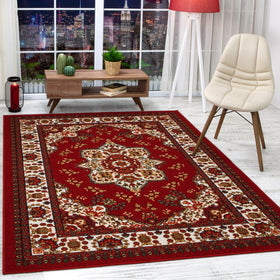
How to Choose the Best Materials for Rugs
Hunting for a new area rug is an excellent start while redecorating your room but choosing the right one might not be so easy! You might already have decided on your rug's placement, size, color, and style. Material is also an essential element you should consider while choosing the best area rugs that meet your expectations.
First, you should figure out whether a natural rug or a synthetic one will answer your demands about rug materials. Both have their unique characteristics which make them either the best choice or the poor one depending on your expectations. You may determine your ideal area rug by answering questions like “Where will be the placement?” “What is your budget?” “Should it be eco-friendly?” and so on.
While reading our guide about natural and synthetic area rugs, think about your essentials to find the suitable material for your area rug.

Natural Rugs
Natural rugs can be made from various materials with unique features. Still, they have some basic similarities that can help you decide whether natural rugs are better options according to your needs. For instance, most natural rugs are made from renewable materials. They are much better options if you wish to decorate your living space with eco-friendly products. Another common feature is that they generally require careful cleaning, so some may not be preferable for high-traffic areas.
Besides their similarities, some essential differences may affect your choice. Here are some of the most popular natural rug materials:
- Wool: As being the most common rug material, wool rugs are preferable for the ones who search for warmth, durability, comfort, and easy cleaning. You may use your wool rug in the living room, dining room, and high traffic areas. You should avoid using wool rugs in wet areas because they absorb humidity. Another feature to consider is that wool is more likely to be subject to fading and shedding.
- Cotton: Cotton is a more budget-friendly alternative compared to other types of natural rugs. They are cozy, soft, antiallergic, easy to clean, and mostly machine washable. Additionally, you may find cotton rugs in many different colors and styles that can be the best fit for your decoration. However, you may wish to consider that cotton rugs might not last as long as wool rugs, and they easily stain when not cleaned quickly.
- Jute: Jute rugs are firm, durable, and generally suitable indoors and outdoors. They are affordable, renewable, and primarily free from chemical processing. Moreover, they are ideal for both indoor and dry outdoor use. You can prefer them in the living room, office, and hallway. Although jute rugs provide unique texture, they are not preferable if you are looking for softness and coziness in your place. Also, they require careful cleaning.
- Silk: Silk rugs present luxurious softness and classiness. Silk area rugs are best for bedrooms and low-traffic areas. They require professional cleaning and sometimes show footprints. Also, silk rugs are one of the most expensive alternatives.

Synthetic Rugs
Synthetic rugs are made out of human-made materials. Over the years, they have become successful imitations of natural rugs. Thanks to their materials and production process, synthetic rugs are cheaper than the others. Moreover, most of them are easy to clean and suitable indoors and outdoors. Unfortunately, they are not sustainable and eco-friendly. The most preferred synthetic rug materials are as follows.
- Polypropylene: Polypropylene is a popular synthetic material because it makes synthetic rugs look exactly like some natural rugs. These rugs are soft, vibrant, functional, and durable. Since polypropylene rugs are easy to clean and stain-resistant, they can be great solutions for the high-traffic area and outdoor decorations. Polypropylene is a highly flammable material, so you should avoid using polypropylene rugs in areas with intense heat, like kitchens.
- Polyester: With an excellent color, style, and texture choice, your polyester rug can look as cozy, soft, and stylish as wool or cotton rugs do. Polyester rugs are easy to clean and suitable for high-traffic areas and outdoors. They have vibrant and bright colors and various styles, sizes, and patterns. They can be used in many different areas and add a great look to your place. Although they are not durable, they can easily be replaced thanks to being affordable alternatives in the market.
- Nylon: Nylon area rugs are among the most popular ones in the industry, thanks to their affordability, durability, stain resistance, and versatility. Also, nylon rugs are suitable for places like restaurants and hotels because of being an ideal choice for heavy foot traffic areas. It would help if you considered that nylon rugs might not be the healthiest option among other synthetic area rugs. Plus, not all nylon rugs are machine washable.
- Viscose: Viscose is human-made material similar to silk. Viscose rugs can beautifully complete your decoration as a cheaper alternative to silk rugs. Since it has a delicate material, viscose rugs are recommended only for dry and low-traffic areas. Note that viscose rugs are prone to shedding, so you should avoid spills and water-based cleaning.
In this blog post, we have shared all the information you need about area rug materials. If you do not feel ready yet, check our blog posts to learn other variables you should consider before purchasing your area rug:
Choosing The Right Area Rugs: A Guide


